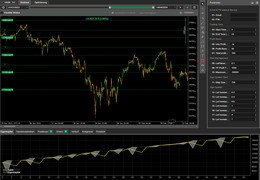Between reality and illusion If you want to know what trading really means—beyond luxury cars, piles of cash, and...
Conduct precise market analyses with ChatGPT: critical analysis and helpful prompts
ChatGPT is often touted as a revolutionary tool in trading, capable of performing accurate market analysis and giving traders a significant advantage. But how well does ChatGPT really perform in this role? In this post, we'll explore the challenges and limitations of using ChatGPT for market analysis, while also offering some specific prompts you can try to get the most out of the tool.
1. The Illusion of Perfection: Why ChatGPT is not flawless
Point of criticism: ChatGPT is highly dependent on the data it processes. Results can be inaccurate if the underlying data is incomplete, outdated, or biased. In addition, the model tends to detect patterns that may not even exist, which can lead to over-optimized results that are of little practical use.
Prompts that can help:
- "Analyze the last five years of historical price data for [stock] and identify any notable patterns. Indicate how stable these patterns are over time."
- "Summarize the most common risks associated with using historical data to predict market trends."
- "Explain how biases in data sets can affect the outcome of a market analysis and how to detect them."
2. The challenge of market sentiment
Point of criticism: While ChatGPT can analyze large amounts of text data, it struggles to account for the emotional and contextual nuances of news and social media. This often leads to misjudgments of market sentiment, especially in situations where human interpretation is crucial.
Prompts that can help:
- "Analyze the current market sentiment on [stock/market] based on the last 100 tweets with relevant hashtags. Summarize the sentiment in positive, negative and neutral categories."
- "Explain the potential risks of relying solely on social media to assess market sentiment."
- "What are common misconceptions when analyzing texts related to market sentiment and how can they be avoided?"
3. The myth of real-time data analysis
Point of criticism: Although ChatGPT can perform rapid analysis, it is often unable to process true real-time data. Delays in data processing and the need for extensive computing resources can result in the delivered analysis being out of date.
Prompts that can help:
- "Explain the differences between real-time data and delayed data in market analysis. What risks arise from delayed data?"
- "What technologies and approaches could minimize delays in data processing?"
- "Make a list of real-time data sources that can be used for market analysis and describe their advantages and disadvantages."
4. Lack of human judgment
Point of criticism: ChatGPT lacks the human judgment that is essential to many trading decisions. Emotions, market psychology and ethical considerations cannot be adequately accounted for by an AI, which can lead to important aspects of decision-making being overlooked.
Prompts that can help:
- "Explain how human intuition and experience can influence market analysis and why they are superior in some cases."
- "Analyze the role of market psychology in major market events and why AI models like ChatGPT often fail to fully capture it."
- "What ethical considerations should be taken into account when automating trading decisions with AI?"
Conclusion: AI is not a miracle cure
Point of criticism: While ChatGPT can be useful, it is far from a perfect solution for market analysis. It is important to understand the limitations of this technology and view it as a tool that complements human capabilities rather than replacing them.
Prompts that can help:
- "Explain in which situations it makes sense to use ChatGPT as a complementary tool in market analysis and when it is better to rely on human expertise."
- "What are the limitations of ChatGPT in market analysis and how can traders take these limitations into account in their strategy?"
- "Create a checklist for traders to ensure that ChatGPT results are meaningfully interpreted and integrated into their decisions."
By critically examining ChatGPT and making targeted use of the prompts mentioned above, you can use the tool more consciously and at the same time better understand its limitations.
Here are 20 real-world examples of how to pass data to ChatGPT to extract useful information from it. These examples include the use of screenshots, texts, documents, PDFs, and more:
1. Text extract from a PDF report
Input: A PDF document containing a financial report. Prompt: "Extract the key financial metrics from this report and summarize them." Expectation: A summary of key metrics such as sales, profits and debt.
2. Screenshot of an email with market analysis
Input: A screenshot of an email containing market analysis for a particular stock. Prompt: "Read the text on this screenshot and identify the recommended trading strategies." Expectation: An overview of the proposed strategies and their rationale.
3. Text block from a business article
Input: A section from an online article about the current economic situation. Prompt: "Summarize the key points of this article and explain how they might affect the stock market." Expectation: A concise summary of the article content with an analysis of the possible market implications.
4. Tabular data in a spreadsheet
Input: A table with historical price data for a stock in Excel. Prompt: "Analyze the price data in this table and identify trends and anomalies." Expectation: An analysis of price movements highlighting trends and possible anomalies.
5. Screenshot of a chart analysis tool
Input: A screenshot from a chart analysis tool showing various technical indicators. Prompt: "Read the technical indicators on this chart and give an assessment of the current trend." Expectation: An analysis of the indicators and an assessment of whether the market is bullish or bearish.
6. Text from a Twitter discussion about stocks
Input: A screenshot or text from a Twitter discussion about a particular stock. Prompt: "Analyze the mood in this discussion and determine whether it is predominantly positive, negative, or neutral." Expectation: A sentiment analysis that reflects the prevailing opinions of the panelists.
7. Paragraph from a book on market psychology
Input: A passage from a book dealing with market psychology. Prompt: "Explain how the concepts described in this section can be applied in practice to stock trading." Expectation: An application of theoretical concepts to the real trading context.
8. PDF document with company data
Input: A PDF containing detailed company data such as quarterly reports. Prompt: "Extract the most important information from this quarterly report and give an assessment of the company's future development." Expectation: A summary of the company’s financial performance with a forecast.
9. Text extract from an analysis by analysts
Input: A text excerpt from an analyst report about an industry. Prompt: "Summarize the key findings from this industry analysis and explain what impact they might have on companies in this sector." Expectation: A brief summary of the analysis with potential implications for the industry.
10. Screenshot of a forum post about cryptocurrencies
Input: A screenshot of a forum post containing a discussion about cryptocurrencies. Prompt: "Analyze the arguments in this post and give an assessment of the credibility of the sources." Expectation: An evaluation of the arguments presented and an assessment of the credibility of the discussion.
11. Text in an online discussion about trading strategies
Input: A text from an online discussion about different trading strategies. Prompt: "Compare the trading strategies mentioned in this discussion and make a recommendation as to which strategy is best suited for volatile markets." Expectation: A comparison of strategies with a recommendation based on market conditions.
12. Section from a company’s annual report
Input: A section from a company’s annual report in PDF format. Prompt: "Identify the key risks and opportunities mentioned in this annual report." Expectation: A list of the risks and opportunities mentioned with a brief explanation.
13. Screenshot of a news site with business news
Input: A screenshot from a news site with current business news. Prompt: "Analyze this news and determine which of them could have the greatest impact on the market." Expectation: An analysis of the news prioritized by market impact.
14. Text from a newsletter about investments
Input: An excerpt from a financial newsletter about investment opportunities. Prompt: "Summarize the recommended investment strategies and give an assessment of how realistic they are in the current market situation." Expectation: A summary of the recommendations with an assessment of feasibility.
15. Section from a study on market trends
Input: A section from an academic study on long-term market trends. Prompt: "Explain how the market trends described in this study could be applied to current market conditions." Expectation: A transfer of theoretical trends to current market conditions.
16. Screenshot of a stock trading portal with live data
Input: A screenshot from a stock trading portal showing live market data. Prompt: "Interpret the live data in this screenshot and provide a brief market analysis." Expectation: A brief analysis of live data with recommendations based on current market movements.
17. Text block from a chat history about financial investments
Input: A block of text from a chat conversation discussing financial investments. Prompt: "Analyze the proposals in this chat and identify the potential advantages and disadvantages of the proposed investments." Expectation: An analysis of the investment ideas with a list of pros and cons.
18. PDF of a market report with industry trends
Input: A PDF market report on current industry trends. Prompt: "Summarize the most important trends in this industry and provide a forecast for the next six months." Expectation: A summary of industry trends with a short to medium term forecast.
19. Section from a blog post about financial technologies
Input: A section from a blog post dealing with new financial technologies. Prompt: "Evaluate the financial technologies presented in this blog post and explain which ones are most likely to impact the industry." Expectation: An evaluation of the technologies with an assessment of their potential impact on the industry.
20. Screenshot of an Excel table with performance data
Input: A screenshot of an Excel spreadsheet showing the performance of various mutual funds. Prompt: "Analyze the performance data in this table and identify the fund with the best risk-return ratio." Expectation: An analysis of the data with a recommendation based on the risk-return profile of the funds.
These examples show how versatile the application of ChatGPT can be in the analysis and interpretation of financial data. Using the right prompts helps to extract valuable information from a wide variety of data formats.

















